MAPS of Great
Infrastructure Development Projects
Around the World
Interactive map
INFRASTRUCTURE DEVELOPMENT CORRIDORS
Magnetically Levitated Trains
Schiller Institute Infrastructure Projects
For World Reconstruction
The Productive Triangle

The Paris-Berlin Vienna Development Triangle,
and it's Spiral Arms
Shortly before he was railroaded into prison in early 1989, Lyndon LaRouche, speaking at an Oct. 12 press conference at Berlin's Hotel Bristol, forecast the reunification of East and West Germany and called for a "Food for Peace" policy, to reverse the down-slide of the Soviet and Eastern European economies over the coming period.
After the fall of the Berlin Wall in November 1989, Mr. LaRouche, writing as a political prisoner, elaborated his Berlin proposal into the policy now known internationally as the "Productive Triangle: Berlin-Paris-Vienna." He called for the creation of an industrial, transport and power grid in the triangle defined by these three capitals, to productively employ the approximately 300 million working people in this area. This Productive Triangle, LaRouche explained, could not only guarantee the recovery of Eastern Europe, but would serve as the engine for global recovery and economic development.
The Schiller Institute and its chairman Helga Zepp LaRouche have organized for this proposal, with increasing interest and acceptance, among leading forces throughout Eastern and Western Europe, including virtually all of the newly freed nations of Eastern Europe, since the revolutions of the late 1980s. In many parts of Eastern Europe today, the Schiller Institute's economic policy is considered the only viable alternative to the dismal failure of communist collectivism and the equally discredited austerity policies of the International Monetary Fund/World Bank.
- The Significance of the 'Productive Triangle' -
Once you determine that the world's governments are going to work together for global reconstruction, you have to know how to approach it. If you are with the World Bank, you will decide to stress redistribution of wealth from the richer countries to the poorer. But if you really want to upgrade the condition of mankind everywhere, you will put a major emphasis upon reinvigorating the most productive industrial centers--so that they can serve as locomotives for rebuilding the world.
In 1989, from prison, economist Lyndon LaRouche took this approach in developing his "European Productive Triangle" concept. The Triangle is named for the Paris-Berlin-Vienna area which forms the industrial and economic core of Europe, including the highest concentration of scientific labor power in the entire world. LaRouche's plan was to prepare this region to be able to rebuild the economic infrastructure of the whole continent, particularly Eastern Europe, through building the most advanced forms of transport, communications, and electric power.
The area of this triangle is approximately 320,000 square kilometers, and comprises almost 92 million human beings. Half of these people live in the immediate environment of the 10 large indsutrial areas of the region. These are industrial centers which are currently seeing their industries and manpower thrown on the scrapheap, because the globalized environment demands an immediate quick profit, and cheaper labor costs. Yet the key to real productivity is not cheap labor and low technology, but the very opposite.
From the Triangle, important infrastructural corridors radiate out in all directions. Some are toward the East; others go toward Africa and the South; still others can stretch to the North and West, providing the basis for upgrading living standards in a region three times the area of the center.
High-speed rail was one of the major components of the Triangle plan, as it would speed the movement not only of people, but also of freight through the area.The technology of choice is magnetic levitation. The second essential infrastructural pillar was the energy supply, with concentration on nuclear power. There is no way that sufficient energy expansion could be achieved--including replacement of the unsafe Chernobyl types of nuclear reactors in the East--without a renaissance of nuclear energy, most likely around the newly developed small reactors.
The Eurasian Landbridge

Read Mrs. LaRouche's 1997 presentation on the Landbridge
On May 7-9, 1996, Helga Zepp LaRouche was a featured speaker in Beijing, China, at an historic International Symposium for Development of the Regions along the Euro-Asia Continental Bridge, with over 460 experts and leading officials from 34 countries. The subject of the symposium was a grand strategy for developing the entire Eurasian landmass, by means of an integrated, transcontinental network of modern transport, energy, water, and communications infrastructure. Beijing's hosting of the conference reflected a major strategic policy thrust of the Chinese government, to promote economic development along the "New Silk Road" formed by the newly established Eurasian Continental Bridge rail lines connecting the Pacific coast of China with the Atlantic coast of Europe.
This Eurasian Land-Bridge concept, Mrs. LaRouche told a Washington, D.C. seminar following her Chinese trip, is entirely coherent with, and influenced by, Lyndon LaRouche's concepts of the Productive Triangle and of the science-driver.
Today, the Schiller Institute is fighting for implementation of the Eurasian Land-Bridge in virtually every nation of the world, as key to reversing the continuing global slide into a New Dark Age. Since the 1996, many governments, policy think-tanks, and other institutions have sponsored conferences, seminars and symposia with speakers from the Schiller Institute, to promote this urgent reconstruction program.
This ongoing dialogue among nations and cultures, based on the concept of Peace through Economic Development, represents the only pathway toward rebuilding the world economy, including especially the development of the underdeveloped nations, and it remains is the only basis for establishing durable peace.

Eurasian Land-Bridge. This map shows, for the largest continuous landmass on our Planet Earth, the main routes and selected secondary transportation routes, which are priority corridors of intended and existing economic improvements, to further economic development for all peoples and nations of this vast expanse of Eurasia--home to nearly 4.5 billion people, three-fourths of the entire world population.
The Eurasian Land-Bridge interconnections to the continent of Africa are also indicated, showing key routes through Cairo, to Lagos in the west, and Nairobi in the east, with spurs going south. The land pathway to the Western Hemisphere is shown in the northeast corner of the map, with the proposed Bering Straits tunnel. The archipelago route to Oceania, and the South Pacific, is shown in the lower right. From this perspective, the ocean basins of the Pacific, Indian, and Atlantic Oceans are waterways for commerce and benefit, not isolating features.
The concept of the Eurasian Land-Bridge approach to economic development, far from being a pie-in-the-sky dream, is a conception which is already happening in key locations, and under discussion for others. Goods are travelling on the railway from Lianyungang, on the coast of the South China Sea, all the way westward through to Rotterdam, on the Baltic Sea.
The heavy black lines show three main East-West intercontinental routeways: in the north, the old Trans-Siberian way through Russia; in mid-continent, the line running through Central Asia and western China; and in the south, a proposed path goes through India, and the Indo-Chinese peninsula. The map's dotted or narrower lines show proposed, existing, and lesser links, as noted in the key.
You can easily read into the map the old trade routes of the "Silk Road" of ancient times, the old "Fur Path" to the north, and so on. The locations of the corridors conform to terrain and economic history.
The name in China for this intercontinental development perspective is "The New Silk Road," and many parts of the infrastructure networks, such as oil and gas lines, fiber optic cables, waterworks, and other projects, are under construction.
In the 1990s, Lyndon LaRouche, his wife Helga Zepp LaRouche, and collaborators, launched an international drive for the Eurasian Land-Bridge, as the "New Silk Road" locomotive for worldwide economic development (See EIR Special Report of January 1997, 290 pages, color map insert.) To think of LaRouche's idea of the "infrastructure corridor," picture a continuous strip of land, approximately 100 kilometers wide, centered on a major inland transport route (such as a railroad line), with parallel lines of high-capacity electric lines, fuel pipelines, water supply lines (perhaps including irrigation), and so on. Thus the precondition exists for ratios of power, water, and other inputs for every kind of industrial, agriculture, mining, and urban activity--the most important one being ingenuity.
back to table of contents
See Also
Eurasian Landbridge Timeline
Helga Zepp LaRouche's 2001 Conference Speech:
" The Eurasian Landbridge- Why Americans SHOULD Go There'"
DEVELOP AFRICA
As the Breadbasket for the World
(links to articles below)
North Africa: The Blue Revolution (Video), German Schiller Institute, 2011
 View enlargement Download poster-size JPEG (9.29 MB) Download extreme hi-resolution PDF (2.6 MB) Proposed new Water projects |
 View enlargement Download poster-size JPEG (9.29 MB) Download extreme hi-resolution PDF (2.6 MB) PROPOSED WATER AND RAIL PROJECTS |
|
|
Proposed Development Plan for High Speed Rail and INFRASTRUCTURE CORRIDORS |
(Compare to the EXISTING RAIL LINES) |
Development Projects for Africa
As early as the 1940s, when President Franklin Delano Roosevelt met British Prime Minister Churchill in Morocco, there has been a clear outlook toward the industrialization of Africa. At the time, Roosevelt told Churchill that it was intolerable that Africa remain a region for extraction of raw materials, and that, after the end of the war they were then engaged in fighting, the resources had to be poured in, in order to educate and develop thriving, modern economies. This was thwarted, but not for lack of plans.
Now, with the era of the International Monetary Fund cracking up, we can put an end to the no-development decades, and return to the perspective of large-scale infrastructure improvements for the great continent.
The plans exist for greening the desert, for expanding waterways, for building rail links and ports, for power, for new cities and agriculture regions. For example, in southern Sudan, over 150 kilometers of a big trench on the upper White Nile was dug (completing half of the proposed Jonglei Canal), and then had to be abandoned, because of IMF-era international opposition.
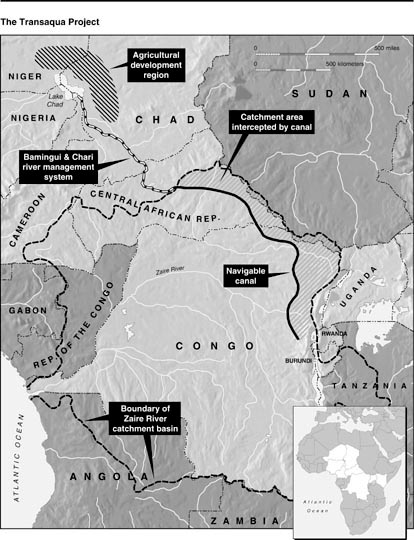
The map here shows a centerpiece project for the entire continent: the development of the vast Zaire (Congo) River basin water resources, which is known as the "Transaqua Project." The inset map of Africa shows the nations directly affected by this project--which are right now, the very nations plunged into bloody strife under the no-development, British neo-colonial geopolitics
The Zaire/Congo River is second only to the mighty Amazon, in terms of huge volume of water. Under the Transaqua Project, a "new river" could be created by diverting water drawn off from the Zaire, and channelling it northward, to refresh and expand the dry Lake Chad basin (on the map, the Bamingui & Chari channel). The Zaire/Congo would "give up" only 5% of its flow, yet, at the point of discharge into the Chad Basin, the flow rate would be a whopping 3,200 cubic meters per second, which is equivalent to almost double the discharge of the Nile River downstream of the Aswan High Dam. Thus, Africa gains a "New
Nile."
The map also shows the route of a navigable canal in this Central African region. The hatched area in Niger and Chad, shows a new agriculture development region that would be opened up, covering 12-17 million acres of intensive and semi-intensive irrigated farming. This is almost double the area now intensively cultivated in Egypt.
Criss-cross this "Transaqua Project" region with priority highways (e.g., a Trans-Africa highway of 6,000 km from the eastern port of Mombasa on the Indian Ocean, in Kenya, to Lagos, Nigeria, on the Atlantic) plus rail links, and Central Africa becomes a world center for
hope and development
1988 LaRouche Article on Developing Africa
1985 Plan to Deliver 25 Tons of Food to Africa
Feb. 2002 Speech of
Zimbabwe Ambassador to Schiller Institute Conference
THE OASIS PLAN FOR THE MIDDLE EAST
LaRouche in 1995: For World Peace,
Start Middle East 'Oasis Plan' Projects Now!
click for detail map of Middle East projects
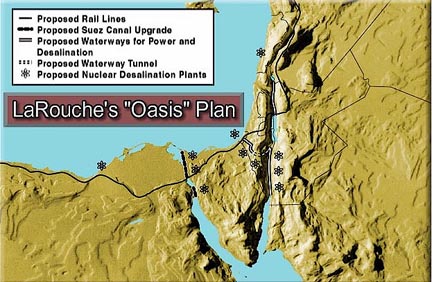
The Middle East (geographically, southwestern Asia) is a crossroads linking the world's largest land masses and greatest population densities--Europe, Asia, and Africa. Thus, economic infrastructure development for this strategic region is a priority for the common benefit of billions of people .As of this writing, January, 1995, there are 210 million people in the 14 nations in the region itself.
Because of its strategic location, the region should be at the top of the world agenda for economic development projects, especially intercontinental rail transit, ports, and adequate supplies of freshwater. Without these projects, the Middle East for decades has been the cockpit of strife extending from northern Africa through the eastern Mediterranean to Central Asia. This potentially rich region has been marked by barbed wire, dead-end roads, fear, and bloodshed.
The Middle East is foremost among development regions today because of the historic peace initiative taken in 1993 by Arab and Israeli leaders. The pact signed in Washington on Sept. 13, 1993 by Palestine Liberation Organization Chairman Yasser Arafat and Israeli Prime Minister Yitzhak Rabin, included Annex III, the "Protocol on Israeli-Palestinian Cooperation in Economic and Development Programs." It listed nine points, beginning with the necessity for providing adequate water and power for the Gaza Strip and West Bank.
"Make the gardens of Jericho bloom again," said Israeli Foreign Minister Shimon Peres. Mahmoud Abbas, the Palestinian representative, spoke on Sept. 13 about how the lack of infrastructure has for too long "drained the population" and caused misery. In July 1994, accords were signed between Israel and Jordan. The example of accomplishments in this region could lead the way to success in key areas all around the globe.
However, as of January 1995, little ground has been broken for needed projects, and what has been, is mostly for hotels and housing for administrators, not basic infrastructure. Fierce opposition to the Peace Accord development perspective has been waged since its signing by financial and political circles associated with the World Bank, International Monetary Fund, and related private interests in the disintegrating Bretton Woods monetary system, and from associated terrorist networks.
Nevertheless, a series of proposals has been put forward for specific projects--many of them on the drawing board for decades--by the Palestinian National Authority (PNA), Israel, Jordan, Egypt, Sudan, and others in the region.
*The PNA in 1994 promulgated plans for 200 projects. Earlier studies, for example, included a 1992 program by the Palestine Studies Project of the Center for Engineering and Planning in Ramallah, entitled "Masterplanning: The State of Palestine: Suggested Guidelines for Comprehensive Development."
*The Israeli government published proposals in a document entitled "Development Options for Regional Cooperation," released in October 1994.
*The Jordanian government put forward proposals in 1994, emphasizing increased water supplies and transportation.
*The Arab League proposed in the 1970s a trans-Arabian and Greater Mideast rail grid, including "Guidelines for Railroad Projects in the Middle East."
*Sudan President Omar El Bashir announced in October 1993 an intention to complete the half-finished Jonglei Canal on the upper White Nile, which would develop the Sudd region in southern Sudan and augment the Nile River flow to the mutual benefit of Sudan and Egypt.
*In Casablanca on Oct. 25-28, 1994, representatives of 60 nations met to confer on economic tasks for the Middle East. A development bank was proposed to finance priority projects. As the new year begins, it is essential to delay no longer on breaking ground.
Lyndon LaRouche's "Oasis Plan" approach, serves as a blueprint for a high-technology-based development approach for the entire region.
LaRouche's 'Oasis Plan'
"Launch an 'Oasis Plan,' " LaRouche proposed, in campaigning for priority project designs for the region. He urged that they be combined with nuclear-powered desalination plants to create "oases" of development.
In 1975, LaRouche visited Baghdad, and subsequently in the year proposed an International Development Bank to fund common-interest infrastructure projects in the Mideast and other regions. In 1986, Peres, then prime minister of Israel, called for a "Marshall Plan" approach, involving high-technology-vectored infrastructure including desalination plants, international electricity grids, and rail and road networks. The Oasis Plan goals cohere with this and also with the program elaborated by Palestinian economists such as Yousef Sayegh.
The priority Oasis Plan projects include:
1) High-speed rail lines through the region, connecting Africa, Asia, and Europe , which presumes a grid of other main lines, and secondary and local lines throughout the Greater Middle East area.
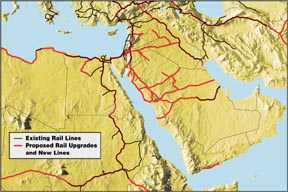
2) Waterway projects, along with nuclear-powered desalination. The Suez Canal, first cut in 1859-69, needs upgrading, and the entire Suez corridor from the Mediterranean to the Red Sea needs to be developed. New waterway-based development corridors can be opened up along 1) a combination canal-tunnel waterway from the Mediterranean to the Dead Sea, beginning near Gaza on the coast, proceeding south of Beersheba as a tunnel through the highlands (about 100 km); and/or 2) a canal from the Gulf of Aqaba to the Dead Sea, through Jordan (180 km).
These waterways can be the site of a series of nuclear-powered desalination plants, around which whole complexes of new industry, intensive agriculture, and residential development can be built--"nuplexes."
The new canals, and selected coastal sites, can thus provide the new resource base for a chain of man-made "oases" through the deserts that will give plentiful freshwater, power, and easy transportation in the lower trans-Jordan Valley region.
Proposals
A second Jordan River. The newest generation of designs for modular nuclear power units are made to order for desalinating seawater. The Asea Brown Boveri-Siemens "potato" reactor, so named for its spherical fuel cells (the pebble bed design), uses a safe thorium cycle. California-based General Atomics has proposed a modular, helium-cooled unit which runs entirely underground. A portion of the energy from either type of unit (at about 135 megawatts), can be handily used for desalinating seawater, and units can be added as required.
With four nuclear power units per installation, only 20 such complexes could desalinate 3,500 million cubic meters of water for the Jordan River basin, the equivalent of a second Jordan River.
Arab rail grid proposals. In the Arabian desert there are ruins of the 19th-century Berlin-to-Baghdad rail system that was dynamited by British terrorists. New rail lines and upgrades of existing lines are shown . These include selected links from Jordanian, Palestinian, and other proposals. In Saudi Arabia, parallel trans-Arabian lines are shown.
Palestinian proposals would also integrate (not shown on the map) new rail lines with superhighway and secondary road development in Gaza and the West Bank, and a connecting corridor between them. The proposed rail line would trace an arc from Irbid, Jordan, into the northern West Bank, up to Jenin, southwest through Tulkarm, with a main link to Nablus, and from Tulkarm southward (just east of Qalqiliya), swinging southwest of Ramallah, with a main branch to Amman, Jordan. From this east-west line, a main line would go southward through Hebron to the Gaza Strip, via Beit Hanun. The West Bank to Gaza corridor would accommodate rail, road, and air links into a network extending throughout the Gaza Strip and into Egypt.
The Israeli government program includes priority rail links from Israel to Lebanon, Jordan, and Egypt.
Build the Gaza infrastructure now
Only 25 miles long and five miles wide, the Gaza Strip has over 800,000 residents (half of whom are under 15 years old), for whom the basic infrastructure of water, power, housing, and social services for a modern economy is lacking, and needs to be built right away. Under the Oasis Plan approach, the Gaza Strip, and the city of Gaza in particular, would be the littoral terminus for a new canal-based corridor of development through the desert to the Dead Sea. The PNA has extensive plans for the area.
A Gaza region "Western Region Development Center"was proposed in an October 1994 Israeli government report "Development Options for Regional Cooperation." Projects outlined include proposed port developments, transportation links to the West Bank, a fuel pipeline, and the Mediterranean Sea-Dead Sea project. Among the basic utility projects, the report calls for constructing 26 water treatment plants.
Create 'natural' resources
The present Jordan River valley flow is capable of supporting about 5 million people on the scale of water per capita required for modern economic activity; however, more than 14 million people already reside in the Jordan basin. Therefore, new "natural" resources must be created by man . A proposal was made for a "northern" Med-Dead conduit taken from the Israeli government "Development Options" report, where the route of Mediterranean seawater is pumped into a canal-conduit south of Haifa, which flows via tunnel under Mt. Carmel, thence to a point in the Jordan basin north of the Dead Sea.
Here the 400-meter drop in elevation would allow the water to "desalt itself" by plunging at the right pressure through reverse osmosis semipermeable membranes. Such a state-of-the-art system operates at 125 pounds per square inch, far less than that of the falling water entering the plant. No extra energy would be required. Engineers estimate that a supply of freshwater equal to the existing flow of the Jordan could be created--a new man-made river. A storage lake is shown in light blue.
However, for many reasons, this option may be far less desirable than other projects. The new freshwater would be under exclusive Israeli control, for example, whereas the Oasis Plan of waterway corridors of development, based on nuplexes, would provide the ratios of water per capita and per kilometer where it is politically and geographically required.
What the maps show is the need to get on with the job. Referring to the proposed Red Sea-Dead Sea canal project, Dr. Munther Haddadin, a Jordanian hydrologist and political leader, told a science reporter in November 1994, "This project started as a dream. But so did peace in the Middle East."
Detail Map of Mideast Projects
Related articles about the Mideast
back to table of contents
Pacific and Indian Ocean Basin
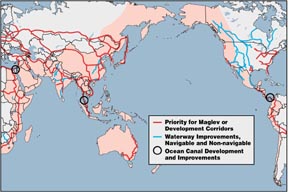
Priority for Maglev or Devlopment Corridors
Waterway Improvements, Navigable and Non-navigable Ocean-Canal Development and Improvements
Southwest ASIA-- Rail Routes and Energy Projects
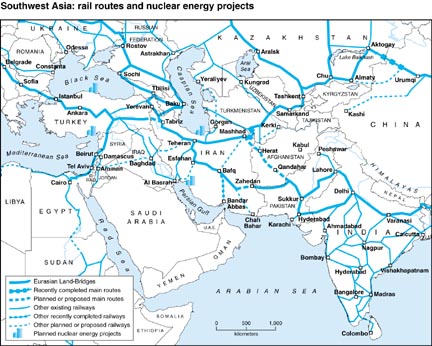
See Helga Zepp LaRouche's article in FIDELIO Summer 1997 for
elaboration of this and other projects.
Australian Ring Rail Map
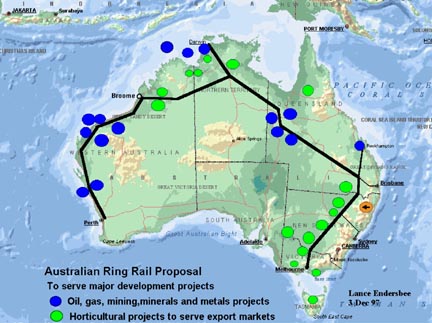
New!
Interview with Lance Endersbee
Former Dean of Monash University in Melbourne, Australia, and Leader in the Effort to Build Great Infrastructure Projects in Australia and Elsewhere, Including the Famous Snowy River Project.


